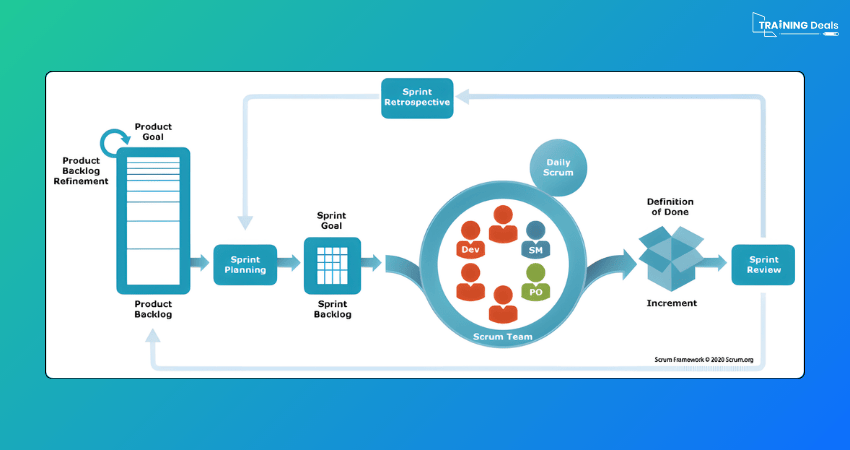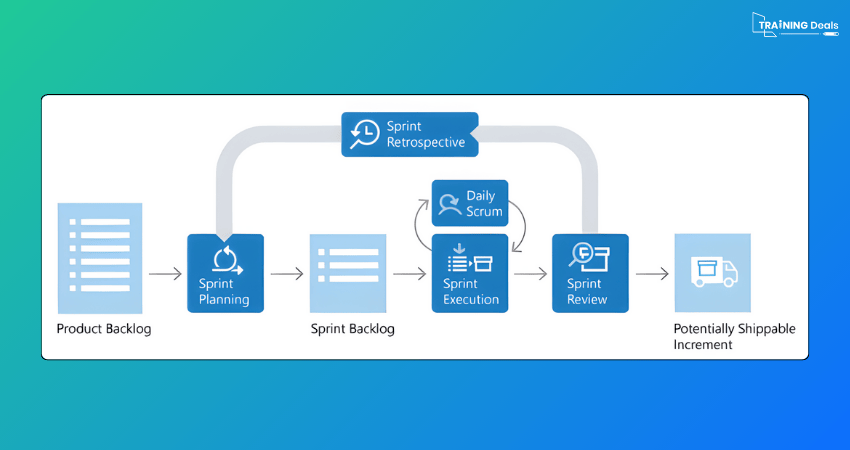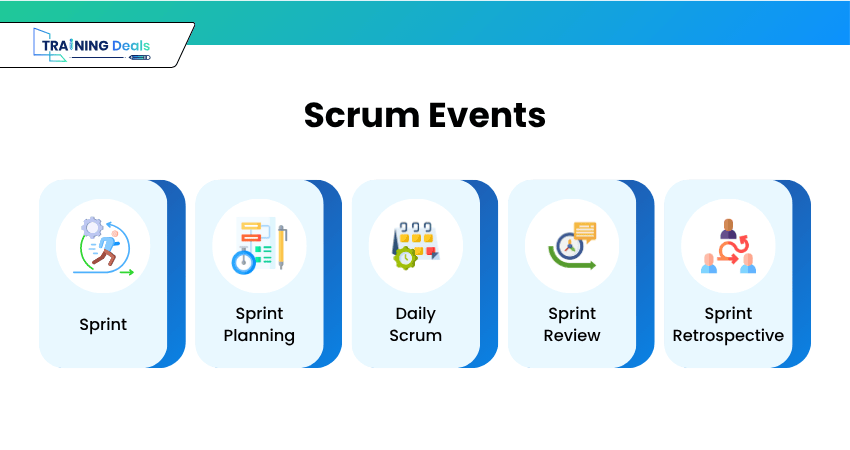

James Smith
Have you worked on a project where plans kept changing, tasks piled up, and progress felt slow? It happens in many busy workplaces today. Priorities shift, deadlines move, and the team can feel lost or stressed. That’s where Scrum makes a difference. It brings structure, clear goals, and teamwork, helping everyone stay focused and move forward even when things change quickly.
In this blog, you’ll learn What is Scrum, how the framework works, key roles, events, artefacts, Agile vs Scrum, and the Scrum lifecycle. By the end, you’ll see how Scrum helps teams stay organised, adapt quickly and deliver work smoothly, one sprint at a time.
Table of Contents
1) What is Scrum?
2) What is Scrum Framework?
3) How Does Scrum Work?
4) Agile vs Scrum
5) Scrum Lifecycle
6) Principles and Values of Scrum
7) Scrum Team Roles
8) What are Scrum Events?
9) What are Scrum Artefacts?
10) Conclusion
What is Scrum?
Scrum is an Agile Project Management framework that helps teams to plan, organise, and deliver work in small, manageable steps. It gives a simple structure with clear roles, regular meetings, and shared tools so everyone stays focused and works together smoothly.
Scrum encourages teamwork, flexibility, and continuous improvement. Teams work in short cycles called sprints, review progress often, and improve based on feedback. This makes it easier to handle changes, solve problems quickly, and deliver better results faster.
What is Scrum Framework?
The Scrum Framework is a simple structure that helps teams work together on complex projects, especially in Software Development. It gives clear steps, rules, and roles so a team can stay organised, communicate well, and deliver work in small, useful parts.

It tells us:
a) Who does what (roles like Product Owner, Scrum Master, and Development Team)
b) What meetings to have (like Sprint Planning, Daily Scrum, and Sprint Review)
c) What tools to use (like the Product Backlog and Sprint Backlog)
How Does Scrum Work?
Scrum divides large projects into smaller, manageable tasks that are completed step by step. The work happens in short time periods called sprints (usually lasting 2–4 weeks), each focused on achieving a clear, shared goal. Here’s how the process works in simple terms:
a) Make a to-do List: The team creates a list of all tasks needed for the project.
b) Choose What to do First: Before every sprint, the team decides which tasks are more important and will be done next.
c) Work Together Each Day: Every day, the team holds a short Daily Scrum (stand-up meeting) to share progress, discuss plans for the day, and address any challenges or blockers.
d) Finish a Small Part of the Project: By the end of the sprint, the team completes a useful piece of work that can be shown or used.
e) Show the Work and Get Feedback: The team presents their completed work during a Sprint Review, where stakeholders provide feedback and suggest improvements.
f) Learn and Improve: Finally, the team holds a Sprint Retrospective to reflect on what went well, what didn’t, and how they can improve in the next sprint.
Agile vs Scrum
Agile and Scrum are related but not the same. Agile is a way of working that focuses on flexibility, feedback, and delivering work in small steps. Scrum is one method under Agile. It uses short work cycles called sprints, daily check-ins, and regular reviews to keep teams organised and moving fast. Here are the key differences between Agile and Scrum:

Scrum Lifecycle
The Scrum lifecycle shows how work moves in a project. Teams complete work in short cycles called sprints (usually 2–4 weeks). Each sprint follows a clear loop to plan, work, review, and improve.
a) Product Backlog: List of all tasks and ideas.
b) Sprint Planning: The team chooses what to do in the sprint.
c) Sprint Backlog: Selected tasks for the sprint.
d) Sprint Execution + Daily Scrum: The team works on tasks and meets daily to share progress.
e) Sprint Review: Team shows completed work and receives feedback.
f) Sprint Retrospective: Team discusses improvements for the next sprint.
g) Increment: A working part of the product is delivered.

Principles and Values of Scrum
Scrum is built on a set of principles and values that guide how teams work together, stay focused, and continuously improve. These ideas promote trust, transparency, and strong collaboration, helping teams deliver high-quality results efficiently. Let’s explore the main principles and values of Scrum.
6 Key Principles of Scrum
Here are the six core principles that shape how Scrum teams operate:
1) Transparent Collaboration and Communication
Everyone in the team shares progress openly, communicates clearly, and works together to solve problems. Transparency ensures that everyone understands what’s happening and builds trust by keeping all information visible.
2) Self-organisation and Collaborative Decision-making
Team members manage their own work and make decisions together. They do not wait for one leader to tell them everything. This gives everyone responsibility and makes the team feel more involved.
3) Flexibility and Continuous Planning
Plans can change at any time based on new needs or feedback. The team reviews the plan often and adjusts when needed instead of sticking to a fixed plan. This helps the team respond quickly when things change.
4) Continuous Delivery and Regular Feedback
Work is delivered in small, usable increments rather than in one big release. Each increment is reviewed with stakeholders to gather feedback early, ensuring that the final product truly meets user needs.
5) Continuous Improvement
After every sprint, the team looks at what went well and what needs to improve. They always try to become better with each cycle. Even small changes can make a big difference over time and help the team grow.
6) Technical Excellence
Scrum emphasises delivering quality at every stage. Teams follow best coding and testing practices to build reliable, well-structured products. Focusing on technical excellence prevents future issues and keeps users satisfied.
5 Values of Scrum
Scrum is guided by five core values that shape how teams think, act, and work together. These values strengthen collaboration and create a healthy, productive environment for success.
1) Commitment
Team members stay dedicated to their goals and support one another to achieve them. Everyone strives to deliver what they promise, building reliability and trust within the team. Strong commitment drives consistent progress and shared success.
2) Courage
Team members speak honestly, take responsibility and face challenges with confidence, even when things are difficult. They are not afraid to share new ideas or admit mistakes. Courage helps the team grow and solve problems faster.
3) Focus
Everyone focuses on the sprint work and avoids distractions so goals can be completed on time. This helps the team keep on track and do better work. Staying focused keeps tasks clear and progress steady.
4) Openness
The team shares progress, ideas and problems honestly. Everyone feels safe to speak up. Openness helps catch issues early and find better solutions. It also builds trust and teamwork, creating a positive space.
5) Respect
Team members value each other's ideas, skills and efforts. They listen, support one another and work as a team. Respect creates a positive and healthy work environment. It encourages everyone to give their best.
Scrum Team Roles
A Scrum Team has three roles: Product Owner, Scrum Master, and Development Team. Each role supports the team in a different way.
1) The Scrum Product Owner
The Product Owner decides what the team should work on to bring the most value. They understand user needs and choose the most important tasks.
In simple terms, the Product Owner:
a) Tells the team what to build next
b) Connects customer needs with the team's work
c) Decides when to release new features
2) The Scrum Master
The Scrum Master supports the team and helps them follow Scrum rules properly. They remove problems, guide the team, and make sure work runs smoothly.

In simple terms, the Scrum Master:
a) Helps the team stay organised and follow Scrum
b) Supports meetings and sprint activities
c) Removes roadblocks and solves team challenges
d) Helps the team improve and learn new ways of working
3) The Scrum Development Team
This Scrum Development Team builds the product. It may include developers, testers, designers, and other specialists. They work together, share skills, and plan how to complete the sprint work.
In simple terms, the Development Team:
a) Works together to finish the sprint tasks
b) Plans how much work they can complete
c) Organises their own tasks without a manager telling them
d) Shares responsibilities and learns from each other
What are Scrum Events?
Scrum Events are structured meetings that keep the team organised, focused, and continuously improving. They create regular opportunities to plan, review, and adapt work throughout each sprint. These events repeat in every sprint to ensure clear communication and steady progress.

1) Sprint
A Sprint is a short work period, usually 2 to 4 weeks. The team chooses tasks and works to finish them within this time. Each sprint has a certain start and end date, and a new sprint begins as soon as the last one ends.
2) Sprint Planning
Sprint Planning occurs at the start of each sprint. The team and the Product Owner decide what tasks to do and how to do them. Once the plan is ready, the team focuses only on those tasks for the sprint.
3) Daily Scrum
The Daily Scrum is a quick 15-minute meeting each day. Team members briefly share what they did, what they will do next, and if they need help. It keeps everyone updated and working together.
4) Sprint Review
At the end of each sprint, the team holds a Sprint Review to demonstrate the work they’ve completed to stakeholders or customers. It’s a chance to gather feedback, discuss progress, and identify new ideas or changes for future sprints.
5) Sprint Retrospective
After the Sprint Review, the team meets again to talk about the sprint. They discuss what went well and what should improve. They choose one small action to make the next sprint better and work smoothly.
What are Scrum Artefacts?
Scrum Artefacts show planned work, work in progress, and completed work. They help the team stay organised and aligned. Here are the main artefacts in Scrum.
1) Product Backlog
The Product Backlog is a list of all ideas, tasks, and features that might be added to the product. It is always growing and changing. The Product Owner looks after this list and decides the order of items based on what is most important.
2) Sprint Backlog
The Sprint Backlog is the checklist of tasks the team chooses to do in the current sprint. These tasks come from the Product Backlog. The team uses this list to stay focused on what needs to be completed during the sprint.
3) Increment
The Increment is the completed work at the end of a sprint. It should be fully ready to use or show to others, without extra changes needed. Each sprint adds a small, finished part to the product.
4) Definition of Done
The Definition of Done is a simple checklist that tells the team when a task is truly finished and ready. If the work does not meet the checklist, it is not done. This helps the team keep the quality good and consistent.
Conclusion
Now that you understand What is Scrum is, it becomes clear why so many teams trust this simple and flexible approach. Scrum helps teams stay focused, communicate openly and deliver value in small steps. With teamwork, feedback and continuous improvement at its core, Scrum turns complex work into manageable tasks and supports better results. When used well, it builds stronger teams and smarter outcomes.





















